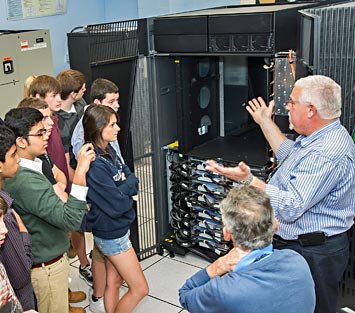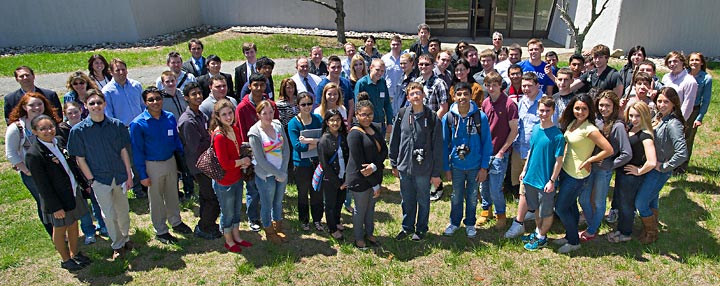Compute This: Students Visit BNL = Possible New IT Professionals
June 3, 2013
On May 1, more than 60 students, accompanied by 10 teachers from 11 Long Island high schools, visited Brookhaven National Laboratory to participate in IT Job Shadow Day. The visit was coordinated by Scott Bronson (Office of Educational Programs) and Christine Caruso (Information Technology Division).
Sponsored by the Chief Information Officers Council and supported by the U. S. Department of Energy, IT Job Shadow Day connects talented high school students to possible internships or future careers with the U.S. government in information technology. Students spend the day learning about the latest technologies and processes used by federal employees and contractors to automate services, provide critical data, secure information, and improve citizens' lives. At Brookhaven, students also learned about the role computing plays in showcasing and capturing scientific data.

Students from various Long Island high schools visited the Lab on May 1 to listen to talks on information technology and visit the Lab's computing facilities.
Students listened to talks on a variety of topics, including "Where is IT Going in the Future? What Will it Look Like When You Get Out of School?" presented by Tom Schlagel, chief information officer in the Lab's Information Technology Division.
In other presentations, Ofer Rind provided information about RHIC/ATLAS computing, and Randy Biegelman and Michael DePhilips spoke on students' cyber profile and cyber security. Michael Villaran spoke about Smart Grid, and David Brown gave a talk on the National Nuclear Data Center.
Ken White, manager of the Lab's Office of Educational Programs, also spoke about the Long Island STEM (Science, Technology, Engineering, and Math) Hub and internship opportunities at Brookhaven Lab.
As part of the day's activities, students toured the RHIC/ATLAS Computing Facility and saw BNL's New York Blue and BlueGene/Q supercomputers.
"Information technology is no longer simply computing," said Schlagel. "Understanding the options and career choices available within the IT field helps guide students when they are submitting college applications and making career choices. Touring students through the Lab's large computing facilities gave them a better understanding of the complexity of computing and how it supports science."
2013-4003 | INT/EXT | Newsroom










